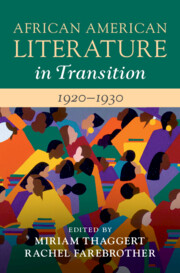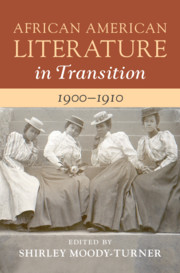Refine search
Actions for selected content:
20 results
Conclusion
-
- Book:
- The Harlem Renaissance Weekly
- Published online:
- 19 November 2025
- Print publication:
- 20 November 2025, pp 214-224
-
- Chapter
- Export citation
Chapter 6 - The “Chocolate Baby” versus the New Negro “Roué”: Revisiting the Mann Act in George Schuyler
-
- Book:
- The Harlem Renaissance Weekly
- Published online:
- 19 November 2025
- Print publication:
- 20 November 2025, pp 198-213
-
- Chapter
- Export citation
Chapter 2 - From “Superman” to Cannibal
- from Battling the Hydra of Profitable Hate in White Newspapers
-
- Book:
- The Harlem Renaissance Weekly
- Published online:
- 19 November 2025
- Print publication:
- 20 November 2025, pp 73-98
-
- Chapter
- Export citation
Chapter 4 - “Saving the Black Man’s Body and the White Man’s Soul”
- from Battling the Hydra of Profitable Hate in White Newspapers
-
- Book:
- The Harlem Renaissance Weekly
- Published online:
- 19 November 2025
- Print publication:
- 20 November 2025, pp 130-157
-
- Chapter
- Export citation
Chapter 3 - “It Is Our Land Just the Same”
- from Battling the Hydra of Profitable Hate in White Newspapers
-
- Book:
- The Harlem Renaissance Weekly
- Published online:
- 19 November 2025
- Print publication:
- 20 November 2025, pp 99-129
-
- Chapter
- Export citation
Introduction - The Harlem Renaissance Weekly
-
- Book:
- The Harlem Renaissance Weekly
- Published online:
- 19 November 2025
- Print publication:
- 20 November 2025, pp 1-36
-
- Chapter
- Export citation
12 - Passing Bodies
- from Part II - Black Optics
-
-
- Book:
- The Cambridge Companion to the Black Body in American Literature
- Published online:
- 09 May 2024
- Print publication:
- 16 May 2024, pp 176-188
-
- Chapter
- Export citation
15 - The Essay in the Harlem Renaissance
- from Part II - Voicing the American Experiment (1865–1945)
-
-
- Book:
- The Cambridge History of the American Essay
- Published online:
- 28 March 2024
- Print publication:
- 14 December 2023, pp 250-264
-
- Chapter
- Export citation
2 - Evading Comstockery
- from Part I - Methodologies
-
-
- Book:
- The Cambridge History of American Modernism
- Published online:
- 13 July 2023
- Print publication:
- 20 July 2023, pp 48-62
-
- Chapter
- Export citation
17 - Anthologies
- from Part II - Forms, Genre, and Media
-
-
- Book:
- The Cambridge History of American Modernism
- Published online:
- 13 July 2023
- Print publication:
- 20 July 2023, pp 303-317
-
- Chapter
- Export citation
Introduction
-
-
- Book:
- The Cambridge Companion to African American Theatre
- Published online:
- 08 June 2023
- Print publication:
- 22 June 2023, pp 1-15
-
- Chapter
-
- You have access
- HTML
- Export citation

The Cambridge Companion to African American Theatre
-
- Published online:
- 08 June 2023
- Print publication:
- 22 June 2023

African American Literature in Transition, 1920–1930
-
- Published online:
- 17 March 2022
- Print publication:
- 07 April 2022
Chapter 14 - Women Writers and the Southern Renaissance; or, the Work of Gender in Literary Periodization
-
-
- Book:
- A History of the Literature of the U.S. South
- Published online:
- 29 April 2021
- Print publication:
- 20 May 2021, pp 227-243
-
- Chapter
- Export citation
Introduction
-
-
- Book:
- African American Literature in Transition, 1900–1910
- Published online:
- 29 April 2021
- Print publication:
- 13 May 2021, pp 1-20
-
- Chapter
- Export citation
Chapter 4 - African American Novels and the New Slavery in the New South
- from Part II - New Negro Aesthetics and Transitions in Genre and Form
-
-
- Book:
- African American Literature in Transition, 1900–1910
- Published online:
- 29 April 2021
- Print publication:
- 13 May 2021, pp 99-123
-
- Chapter
- Export citation

African American Literature in Transition, 1900–1910
-
- Published online:
- 29 April 2021
- Print publication:
- 13 May 2021
Chapter 8 - Modernist Biography and the Question of Manhood: Eslanda Goode Robeson’s Paul Robeson, Negro
- from Part II - Experimenting with the New Negro
-
-
- Book:
- A History of the Harlem Renaissance
- Published online:
- 20 January 2021
- Print publication:
- 04 February 2021, pp 144-158
-
- Chapter
- Export citation
Chapter 2 - Making the Slave Anew: History and the Archive in New Negro Renaissance Poetry
- from Part I - Re-reading the New Negro
-
-
- Book:
- A History of the Harlem Renaissance
- Published online:
- 20 January 2021
- Print publication:
- 04 February 2021, pp 38-54
-
- Chapter
- Export citation
Chapter 15 - Zora Neale Hurston’s Early Plays
- from Part IV - Performing the New Negro
-
-
- Book:
- A History of the Harlem Renaissance
- Published online:
- 20 January 2021
- Print publication:
- 04 February 2021, pp 271-289
-
- Chapter
- Export citation
